Getting to Santa Elena
Although Santa Elena isn’t far from La Fortuna as the crow flies, if you’re not blessed with a set of wings or a Flying Ford Anglia à la The Weasleys, it takes the best part of four hours to get there. We organised our transfer through Arenal Observatory Lodge, and the journey went as follows:
- Taxi | Picked up from AOL at approx. 08:15 and taken to Lake Arenal. This took about half an hour.
- Boat | We handed our voucher to the boat operator, and waited for the boat to fill up. It took around 45 minutes to cross Lake Arenal.
- Taxi | On the other side of Lake Arenal, an assortment of taxis and minivans await. We hadn’t a clue where we were supposed to go. Fortunately, someone with a clipboard was able to find our names on their list and point us in the direction of the right bus. This leg of the journey took an hour and a half (excluding the time spent at the rest stop).
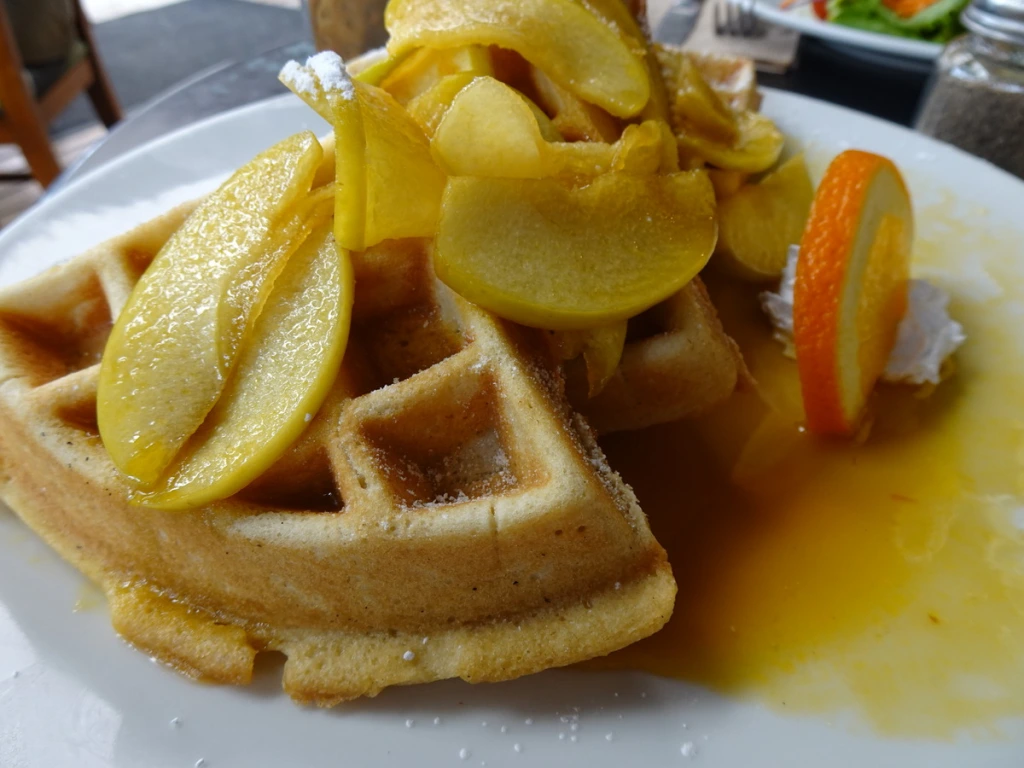
After checking into Cabinas Eddy, we stopped by Café Orquídeas for a bite to eat. Prices were steeper than the guidebook’s single $ symbol would suggest (and for what we felt was quite average food) – but up until this point we had mostly been eating at cheap local sodas, rather than cafés and restaurants catering predominantly to tourists. On the upside, we found ourselves with just enough time left in the afternoon to explore Bajo del Tigre.
Bajo del Tigre (Children’s Eternal Rainforest)
Children’s Eternal Rainforest is the largest biological reserve in Costa Rica, and a small chunk of it – Bajo del Tigre – is easily accessible from Santa Elena. Unlike neighbouring Monteverde Cloud Forest Reserve, you don’t need to make reservations in advance. We had two and a half hours until the reserve closed, which was enough time to explore almost all of the trails.
We didn’t see a huge amount of wildlife, but we did manage to spot a three-wattled bellbird. (If your experience is anything like ours was, you’ll hear their distinctive call before you catch a glimpse of one.) Mostly, it was nice to have the trails pretty much to ourselves.
We saw an agouti scamper away into the undergrowth… and then a stroke of luck: a troop of capuchin monkeys above us. I only managed a couple of decent photos, as when these little guys are on the move, they move fast.
We decided to walk back down to Santa Elena (it’s about 3km, and all downhill), as we wanted to investigate the CASEM Coop en route. This turned out to be an absolute treasure trove of locally-made crafts. We treated ourselves to a small felt toucan, which spends most of the year hanging from our noticeboard and the festive season atop our Christmas tree.
- Tickets | USD$17pp in July 2023.
- Open | Every day from 07:00; no reservation required. Night tours take place daily at 17:30 (pre-booking is essential for these).
Monteverde Cloud Forest Reserve
I’ll start by saying that I wasn’t the biggest fan of Monteverde Cloud Forest Reserve. Although they limit the number of visitors at any one time, it somehow still felt more congested than other places. Secondly, as much as I love plants and greenery, it weighed a little too heavily on that side for me (wildlife sightings were few and far between). The clue is in the name, I suppose – Monteverde literally translates from the Spanish as ‘green mountain’.
We had booked the Natural History Tour for 07:30, which meant catching the 06:15 bus to Monteverde Cloud Forest Reserve (800₡ each, roughly £1.20). Fortunately, the bus stop was pretty much opposite where we were staying, so it didn’t take much brain power or time to get there.
Just before you reach the entrance to Monteverde Cloud Forest Reserve itself, there is a little flight of steps leading to the Monteverde Hummingbird Gallery. It is undeniably an easy place to photograph these brightly-coloured birds up close – but this comes at a cost to the local ecosystem. A local guide at Curi-Cancha Reserve (which we visited the following day) told us that feeders had been banned in Costa Rica. When hummingbirds have unrestricted access to sugar syrup via feeders, they choose the syrup over pollinating plants. The result? Reduced biodiversity, due to the hummingbirds no longer pollinating plants.
Fifteen minutes or so before our tour was due to begin, we joined the queue at the ticket office (which is – unintuitively – hidden right at the back of the gift shop). Keep hold of the receipt: if you leave the reserve to use the toilets or visit the café, you will need to show the receipt in order to collect another entry pass card to re-enter the reserve. We found the tour very informative, though judging by the notes I took at the time our guide was a big tarantula fan. I have far more facts about them jotted down than I do about anything else we saw on the tour. Maybe one day these little factoids will come in handy in a pub quiz…
- Only female tarantulas live in caves. They spend 3-4 months in their cave while their eggs hatch.
- They can have 300-500 babies (and they will eat some of them).
- Their eyesight is poor; the tiny hairs all over their body help them sense movement.
- Shedding their hair irritates predators’ eyes.
- Tarantulas can grow as big as an outstretched (adult) palm of the hand. (Ew.)
As our tour focused on only a couple of the reserve’s many trails, that left plenty of trails for us to explore afterwards.
Before catching the bus back down to Santa Elena, we swung by the Monteverde Hummingbird Gallery for one last look at the hummingbirds. For such tiny birds, they truly are remarkable. They can weigh as little as 3g (though most of the species we saw weigh in at 6-12g). They are the only species of bird that can fly forwards, backwards and (even if only briefly) upside down. And their dazzling jewel-coloured plumage is simply the result of light reflecting off their feathers – without that, they would appear a less-exciting shade of brown or black.
- Tickets | The Natural History Tour cost USD$45pp in July 2023. You can save money by not taking a tour, but the flipside is that you probably won’t know what you’re looking at. (I certainly wouldn’t have done, in any case.)
- Open | Every day from 07:00 to 16:00. Tickets can be purchased on the day (payment is accepted in either USD$ or CRC₡, in cash or by card), but reservations are strongly recommended.
- More information | Visit their website for details on current ticket prices, getting there, parking and trails: https://cloudforestmonteverde.com/. At time of writing, there is a notice on their website saying that tickets must be reserved via email.
Curi-Cancha Reserve
One of Laurence’s must-dos for this trip was a private birdwatching tour. I’m glad it was, as it led us to Curi-Cancha Reserve – which quickly became my favourite reserve that we visited in this area. We were up bright and early to catch the first bus of the day to Curi-Cancha Reserve (600₡ each, roughly 90p).
As Curi-Cancha Reserve doesn’t open until 07:00, the first half hour was spent identifying various birds around the car park: a keel-billed toucan, pigeons (red-billed, band-tailed and ruddy, all of which looked rather prettier than those in our garden back home) and a pair of squirrel cuckoos. David kept a list of all the birds we saw, which he emailed to us afterwards (a great help when it came to sifting through my photos a year on!).
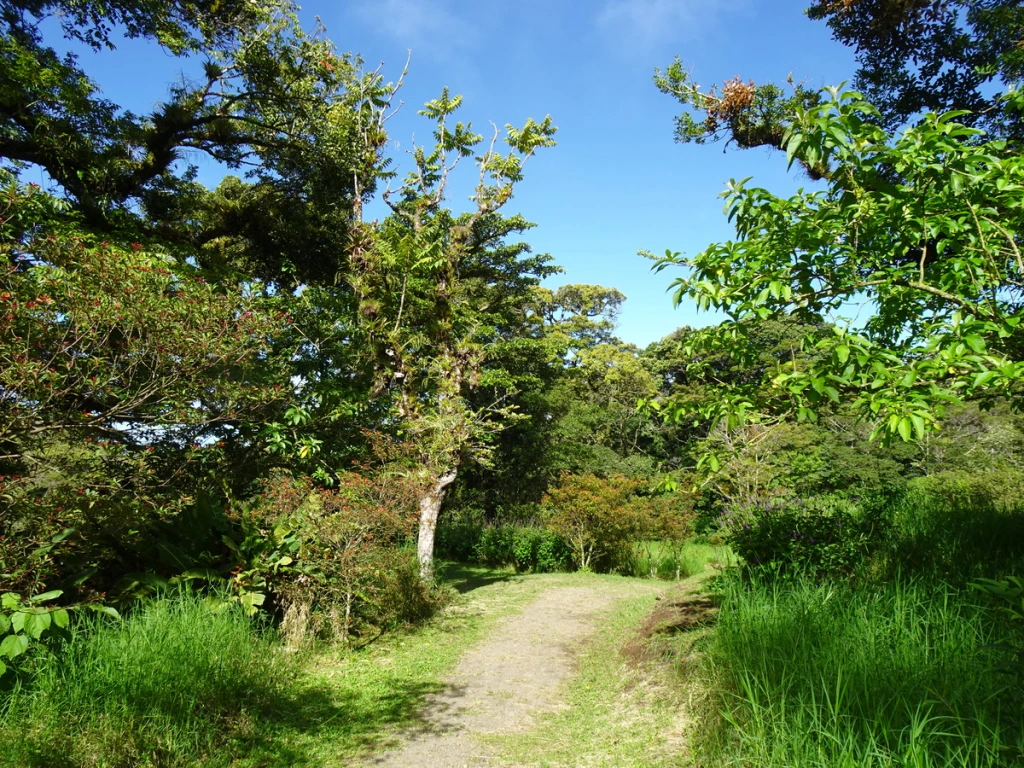
Whereas Bajo del Tigre, Monteverde Cloud Forest Reserve and Santa Elena Reserve are all set on densely forested slopes, Curi-Cancha is far more open, thereby offering a variety of habitats for wildlife.
Over the course of the next few hours, we saw all sorts of birds, including vultures (one black vulture, one turkey vulture), brown-hooded parrots, an assortment of hummingbirds and a red-legged honeycreeper.
My favourites were the mottled owls and the resplendent quetzal. We had only caught a fleeting glimpse of a quetzal at Monteverde Cloud Forest Reserve, so when another guide spotted its distinctive bright-blue tail feathers in the treetops and called us over we were delighted at the prospect of a better sighting. (Prime quetzal-viewing season is February to July – or when the avocado trees which it feeds upon are fruiting – and our trip coincided with the tail end of this timeframe.) Thanks to David’s scope, I have some passable photos of this colourful bird.
Leaving the quetzal behind, we passed a strangler fig. These trees, as their name suggests, select a ‘host’ tree and slowly strangle it. Eventually, only the fig tree remains.
David then spotted something close to the ground: thorn bugs. These small creatures attach themselves to a branch, where they stay until the nymphs have grown big enough for them to move on, and disguise themselves as thorns. Pretty nifty!
We spent a few more hours exploring the trails after our tour, and an agouti finally – finally! – stayed still long enough for me to photograph it.
Before leaving Curi-Cancha Reserve in search of an ice cream from Monteverde Creamery and a late lunch at CASEM Coop, we spotted capuchin monkeys above us. (I don’t think I could ever get bored of seeing monkeys so close up!)
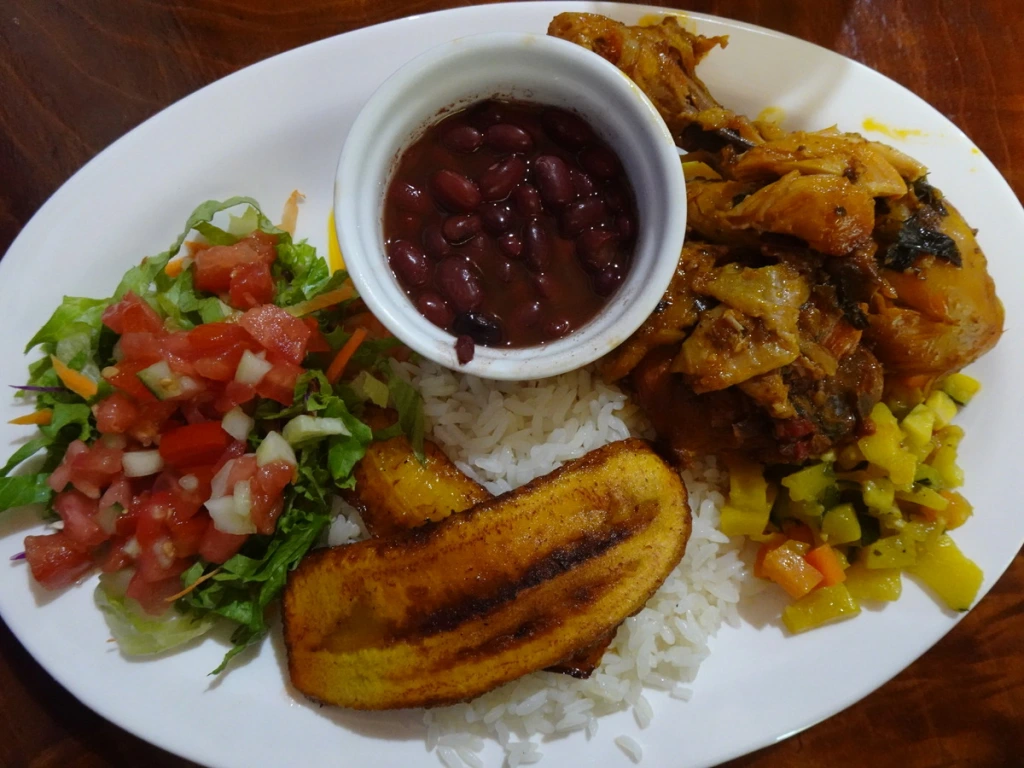
A few hours later, we were back at Curi-Cancha Reserve for our last night tour of the trip. By this time, the mottled owls were in hunting mode and had relocated to more exposed branches. We saw two snakes: one balanced on thin branches up a tree, the other coiled and waiting to prey on unsuspecting tadpoles. According to our guide, baby vipers are more dangerous than fully-grown vipers. This is because they can’t control their venom, so they eject all of it in one go if they feel threatened. Zoom is your friend for photographing these wee beasties!
Being able to go inside a strangler fig tree was a neat (and new-to-us) experience. And last, but by no means least, we saw this Colin the Caterpillar lookalike.
- Tickets | During the day, both self-guided and guided tours are available. As we booked one of their private birdwatching tours (in July 2023 this was USD$110pp), I can’t recall whether it was essential to book self-guided tickets in advance. Night tours must be booked in advance. You will need to present photo ID (e.g. passport, driving licence) when you arrive.
- Open | Every day from 07:00 to 16:00.
- More information | Visit their website for details on current ticket prices, getting there, parking and trails: https://reservacuricancha.com/en/.
We rounded the day off with a sharing platter of mushroom, chicken, pork and beef tacos at Taco Taco, which was one of my favourite eateries of the entire trip.
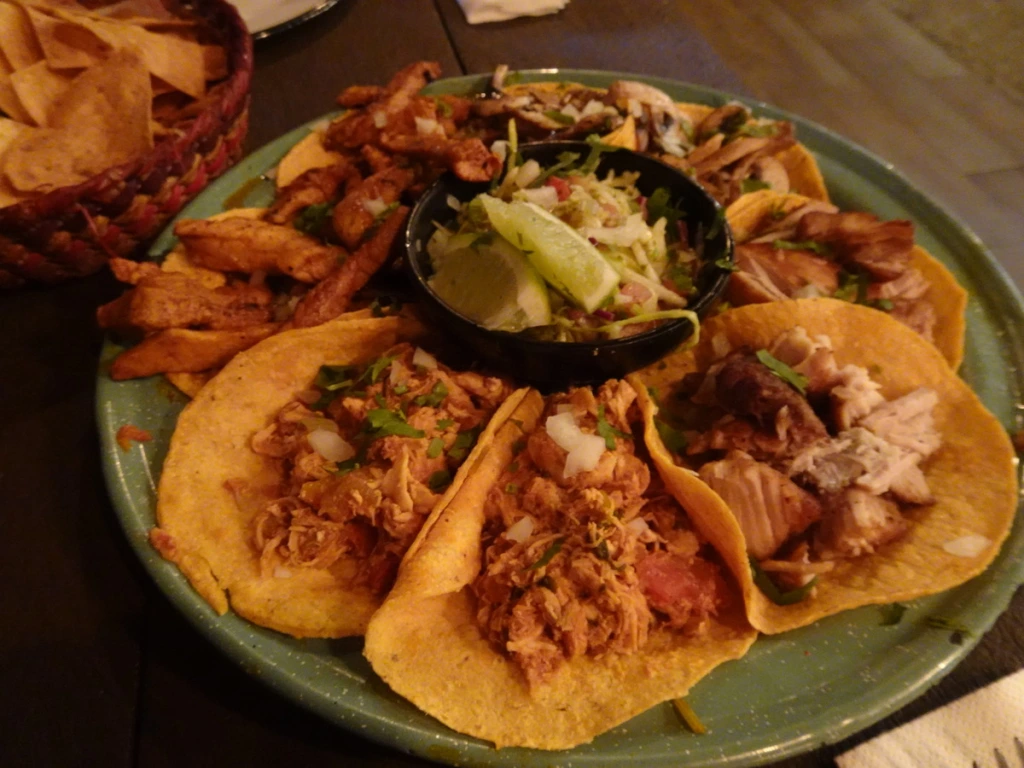
Santa Elena Cloud Forest Reserve
If you’ve not got your own set of wheels, the best way to reach Santa Elena Cloud Forest Reserve is via the shuttle service from Santa Elena. We weren’t sure how much time we’d need or want there, so we opted for the first shuttle of the day at 06.30. The journey – along pothole-filled, bumpy roads – took about half an hour, and the heavens opened almost as soon as we arrived.
We steadily worked our way round the trails: blue first, then yellow, then green. (We gave the longer red trail a miss, as by this point the rain had set in and we doubted we’d see much in the way of wildlife.) On most of these, we didn’t see – or hear – another soul.
One of the best bits about Santa Elena Cloud Forest Reserve is the Observation Tower. Getting there early has its perks, namely being able to enjoy this before the tour groups arrive. (We left this until the end and only narrowly avoided being caught up in a big group tour, so I would recommend going here first if you want to enjoy it in peace.) On a clear day, you can see Arenal Volcano to the north.
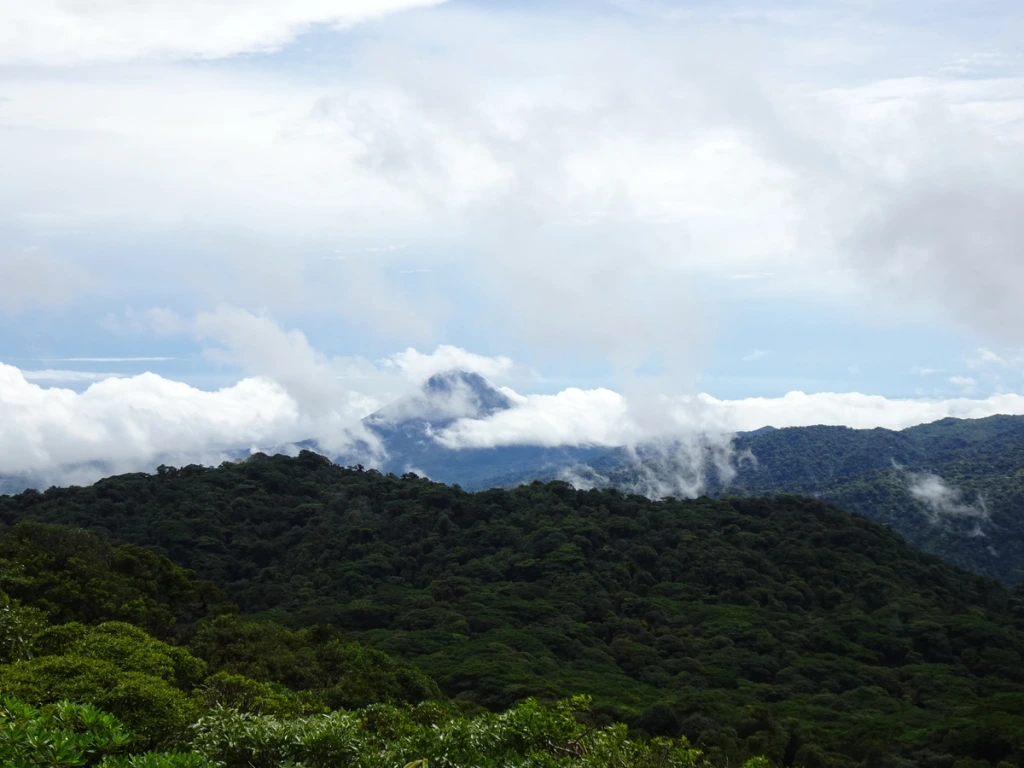
We enjoyed a hot chocolate and some food at the onsite café, and caught the 11.00 bus back to Santa Elena. If it had been dry, we would probably have spent more time there. As it was, four hours in near-constant drizzle was enough for us – and it left us with the afternoon free to do a chocolate tour at Café Caburé, so I can’t really complain.
- Tickets | Santa Elena Reserve isn’t as popular, and reservations aren’t required. Entry was 9,500₡ (approx. £13.80) per person in July 2023 (card and cash accepted).
- Open | Every day from 07:00 to 16:00.
- Getting there | You can book a shuttle to Santa Elena Reserve via WhatsApp (ask your hotel for details). In July 2023, it cost USD$8 per person for a return ticket. Pay in cash when dropped off at the reserve, and retain the laminated card with the bus times printed on it as this serves as your return ticket. There is parking at the reserve, though you’ll want a rental car with decent clearance.